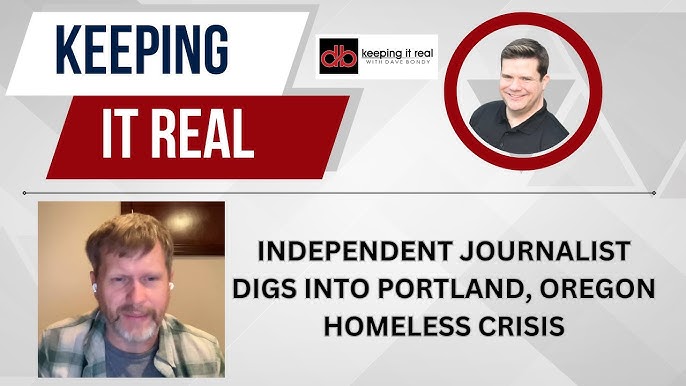PORTLAND, Ore. — For more than two decades, Kevin Dahlgren has been on the front lines of Portland’s homelessness crisis — not as a politician or nonprofit executive, but as an independent journalist determined to reveal the raw, unfiltered truth of life on the streets.
Dahlgren, who has over 25 years of experience working directly with homeless individuals, says what most Americans see in mainstream coverage only scratches the surface. His videos and reports, shared through his Substack newsletter Truth on the Streets, depict scenes that are often too disturbing or uncomfortable for traditional outlets to air.
“I focus on homelessness, addiction, and mental health,” Dahlgren explained. “But I also talk about what I call the homeless industrial complex — because I worked at these nonprofits for years and realized just how dysfunctional and even corrupt they are. What once was a cause has become this billion-dollar industry, which is Homeless Inc.”
Also Read
A Personal Mission
For Dahlgren, the fight to expose the truth about homelessness is deeply personal. His younger brother became addicted to methamphetamine and ended up living on the streets of Portland.
“Trying to get him help in that system was extremely difficult,” he said. “I always assumed when someone was ready for help, it was there. And that wasn’t the case.”
Despite years of effort, Dahlgren’s brother eventually died after a long struggle with addiction and homelessness. That loss, he says, became the driving force behind his mission to hold Portland’s homeless services accountable and to humanize those caught in the crisis.
The Myths and Realities of Life on the Streets
In his reporting, Dahlgren challenges many of the stereotypes often attached to unhoused people.
“They are far more intelligent than people realize. They’re extremely streetwise,” he said. “A good 90% have gone through something pretty severe when they were younger — trauma that led them to addiction, the streets, or mental illness.”
Dahlgren says these individuals are not the “lost causes” society often paints them to be, but victims of broken systems and untreated trauma. His firsthand interviews reveal recurring stories of abuse, neglect, and institutional failure.
Following the Money
Perhaps the most controversial part of Dahlgren’s work is his criticism of the institutions meant to address the problem. He argues that despite hundreds of millions of taxpayer dollars being poured into homelessness programs, little of it reaches those who need it most.
Portland currently spends an estimated $740 million a year on homelessness — roughly $80,000 per person — yet Dahlgren says 95% of the people he’s spoken to have “never been approached by an outreach worker.”
“Where is the money? Where is it going?” he asked. “The system is not designed to end homelessness — it’s designed to sustain it. Too many people are getting paid to keep it going.”
He points to a network of nonprofits, contractors, and administrative bodies that he believes have grown dependent on crisis funding. “It’s become a business model,” he said. “And the people suffering in the tents are the ones paying the price.”
Disturbing Discoveries
The scenes Dahlgren captures in his reporting are heartbreaking. In one of his investigations, he documented children under three years old living in a Portland squatter house surrounded by drug paraphernalia, including used needles and fentanyl foil.
“It was as bad as it gets,” he recalled. “You’re talking about babies in a house full of addicts and chaos. It was a nightmare.”
He says the situation has deteriorated sharply in recent years. “I’ve found more bodies on the streets of Portland in the last year than in my combined 30 years of doing this work,” he said, attributing most of those deaths to drug overdoses, particularly fentanyl.
A Disconnect Between Politics and Reality
While city officials and state leaders insist that Portland’s recovery efforts are making progress, Dahlgren paints a different picture.
“The scary thing is, why won’t many of the Oregon politicians admit this?” he asked. “Even if you’re in North Korea, if you look up, it’s going to look nice — but if you look down, you’ll see something far worse.”
He argues that political leaders are more focused on appearances and policy announcements than on addressing the human suffering playing out daily in plain sight.
‘Truth on the Streets’ — Journalism With Purpose
Through Truth on the Streets, Dahlgren publishes videos, photos, and written accounts of what he encounters during his outreach work. His posts often go viral for their unflinching depiction of real people living and dying on Portland’s streets — people, he says, who have been ignored for too long.
“People are dying, people are suffering, people need legitimate help,” he said. “Someone like my little brother is out there right now — someone who’s loved, someone who matters. These are people with families who care about them.”
Despite his growing audience, Dahlgren admits his work comes with significant personal and financial sacrifice.
“Independent journalism doesn’t pay,” he said. “I make almost no money. Substack is the one place where people can support my work.”
Beyond Awareness — A Call to Action
For Dahlgren, the purpose of his reporting isn’t simply to shock — it’s to demand accountability and change. He hopes that by documenting the true conditions of homelessness, more Oregonians will begin questioning how billions in public spending can coexist with growing tent cities and mounting overdose deaths.
“It’s not about politics. It’s about humanity,” he said. “If people really saw what’s happening out here, they’d never accept it. My job is to make sure they see.”
Through his lens, Dahlgren continues to chronicle what he calls the “forgotten corners” of Portland — where lives unravel in silence and where, despite billions in funding, hope remains the scarcest resource of all.












